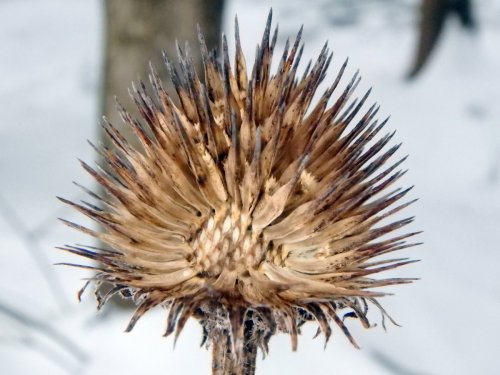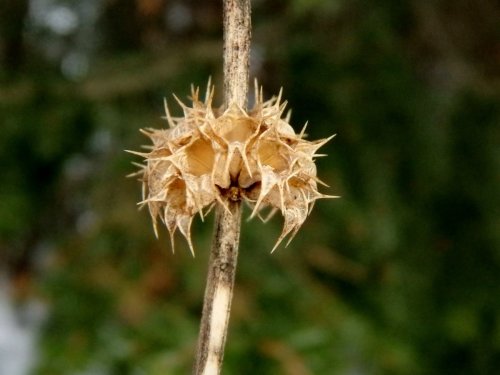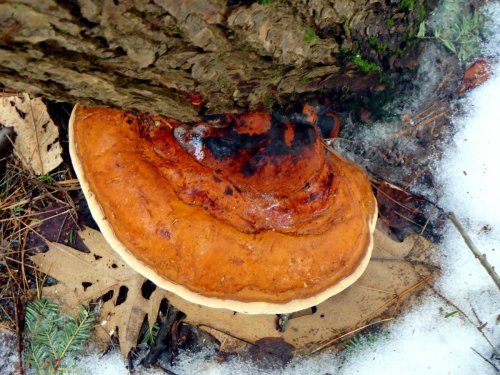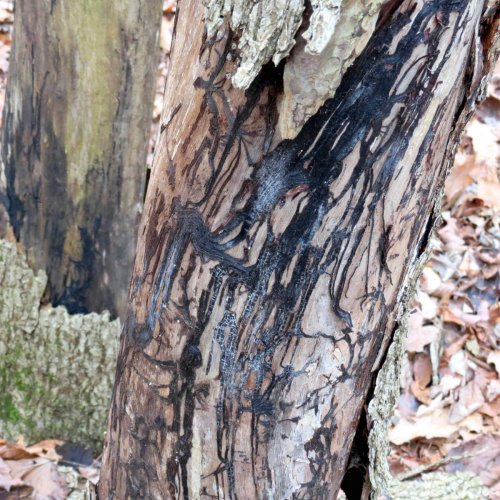We haven’t been seeing a lot of sunshine yet this year but I did see a bit of it caught in the Ashuelot River recently.
By the time I pointed the camera at the sky though, it was gone.
We’ve seen slightly above average snowfall for the season and to show you how deep it is now I took a shot of this fire hydrant, which actually should have been shoveled out in case of fire. Anyhow, the snow is melting again now and by the time you see this quite a lot of it should be gone.
The weather hasn’t been all snow and cold all the time. We’ve had very up and down temperatures and a few days that were warm enough to send me out looking for witch hazel, which is our latest (and earliest) blooming flower. I found some color, but it came from what looked like two or three blossoms that had lost the battle to the cold. That was probably the last chance I’ll have to see our fall blooming witch hazel flowers (Hamamelis virginiana,) but the spring blooming vernal witch hazels (Hamamelis vernalis) will be along next month.
I went to see if there was any sign of willow buds swelling but instead of seeing furry gray catkins I saw furry gray willow pine cone galls. These galls appear at the branch tips and are caused by a midge (Rabdophaga strobiloides) laying eggs on them. Once the eggs hatch the larva burrow into the branch tip and the plant reacts by forming a gall around them. The galls are about as big as the tip of a thumb.
I saw this spider indoors at work one day and took a couple of photos and then let it be. Hours later at home it felt like something was crawling on my lower leg so I stamped my foot hard and out fell a spider that looked exactly like this one. I doubt very much that a spider could have been on my leg all day without my knowing it, but I still had to wonder where and when it had decided to hitch a ride with me. It’s possible that it was in my car but that sounds doubtful too. Maybe it was right here at home and I just didn’t see it. I guess I’ll never know. I haven’t had any luck identifying it, so if you know its name I’d love to hear from you.
A waxy coating called bloom on juniper berries reflects the light in a way that makes the deep, purple black berries appear to be a bright and beautiful blue. This waxy coating is common on fruits like blueberries, on black raspberry canes, and even on some lichens. Though the fruit is called a berry botanically speaking it is actually a seed cone with fleshy, merged scales. Birds love them and I was surprised to see them so late in the season.
Many gin drinkers don’t realize that the flavor of gin comes from the juniper plant’s berry. It is the unripe green berry that is used to make gin. The ripe berry is the only part of a conifer known to be used as a spice. Whole and / or ground fruit is used on game like venison, moose, and bear meat, and man has used juniper for a very long time. The first record of usage appears on an Egyptian papyrus from 1500 BC. Egyptians used juniper medicinally and Native Americans used the fruit as both food and medicine. Stomach disorders, infections and arthritis were among the ailments treated. Natives also made jewelry from the seeds inside the berries.
The maple leaf viburnum (Viburnum acerifolium) in my yard had a single, dark purple berry left on it. I was surprised how textural it was when I saw the photo. Birds seem to love these berries and most of them go fast, but I always wonder why they leave the ones that they do. They obviously know something that I can’t fathom. The shrub is also called arrow wood and some believe that Native Americans used the straight grained wood for arrow shafts.
This is the way the rest of the maple leaf viburnum looked; picked clean.
There are plenty of coneflower (Echinacea purpurea) seeds left so the birds must be happy. I always let plants go to seed in my own yard because I don’t use bird feeders due to occasional visits from bears, and they feed a lot of birds. Speaking of bears, state biologists say the acorn crop was large enough to feed bears through the winter, so many of them aren’t hibernating. I can’t say that was wonderful news, but at least the bears aren’t starving.
The motherwort seeds (Leonurus cardiaca) have all been eaten now. A helpful reader told me that she has seen goldfinches eating the seeds of motherwort, so they must be doubly happy because they eat the coneflower seeds too. I hope one day to be able to see them doing so. They must come when I’m at work because I never see them.
I saw a young, beautifully colored hemlock varnish shelf bracket fungus (Ganoderma tsugae) growing at the base of a young hemlock tree. This mushroom has been used medicinally in China for centuries and is considered the most important of all the herbs and substances used in Chinese herbal medicine, including even ginseng. In China it is called the Reishi mushroom and scientists around the world are researching its anti-cancer potential. The number of beneficial things growing in the world’s forests that we know nothing about must be mind boggling.
Honey mushrooms (Armillarea mellea) once grew on this tree and I know that because their long black root like structures called rhizomorphs still clung to the dead tree. Honey mushrooms are parasitic on live wood and grow long cream colored rhizomorphs between the wood and its bark. They darken to brown or black as they age, but by the time we see them the tree has died and its bark is falling off. The fungus is also called armillarea root rot or shoestring root rot. It causes a white pulpy rot in the wood and kills many species of both soft and hardwood trees. Fallen logs will often still have the black rhizomorphs attached to them.
A couple of posts ago I talked about poison ivy (Toxicodendron radicans) and how it can grow as a shrub, creep along the ground, or climb like a vine. When the plant climbs as a vine it holds onto what it climbs with masses of roots all along the stem, but the example I showed in that post had only a few roots showing. The example above is more typical of what I see, with matted roots all along the stem. I can’t think of another vine that does this so I think it’s a good way to identify poison ivy.
It’s a good idea to leave any vine that looks like this one alone.
I saw this yellow something on the bark of a dying black cherry tree and at first thought it might be a large lichen colony, but it didn’t look quite right for lichen. I knew it wasn’t moss either, so that left one possibility: algae. A few posts ago I showed a hemlock trunk that was all red and another helpful reader helped identify it as a red algae growth, so after some research I found that there is also yellow-green algae, and this example is possibly one called Desmococcus olivaceous, which is also called Pleurococcus vulgaris.
Pleurococcus algae grow on the shaded sides of tree trunks, and on rocks and soil and sometimes even on walls if they’re damp enough. Their closest relatives grow in lakes and rivers but they can withstand dryness. There is fossil evidence of algae colonies existing even 540 million years ago so they’ve been here much longer than we have, and they haven’t changed much in all that time.
Raccoons, so I’ve always thought, are nocturnal animals rarely seen during the day, so my first thought when I saw this one was that it might be sick. Unfortunately they can and do get rabies and it isn’t all that uncommon in this area to hear of people or pets being attacked by rabid raccoons. But this one was eating and after I thought about it I didn’t think if it were sick it would be eating with such gusto. After a little research I found that raccoons often go out in search of food and water during the daytime, especially nursing mother raccoons, usually in the spring.
From what I’ve read you can tell that a raccoon is sick because it will look sick. They’ll be lethargic and stagger when they walk and sometimes will even fall over. If they look alert and bright eyed and run and walk normally then you can be almost certain that they don’t have rabies. I saw this one walking around and it looked fine so I doubt that it was sick. I couldn’t tell if it was a mother raccoon or not but it sure was cute with its little hands looking as if it were begging for more food. For those who’ve never seen one raccoons are slightly bigger than an average house cat. Maybe a chubby house cat; males can weigh 20 pounds. I’m sorry about the quality of the photos of it. All I had for a camera when I saw it was the small point and shoot I use for macros so they aren’t great, but since they’re the only shots I’ve ever gotten of a raccoon they’ll have to do.
If you reconnect with nature and the wilderness you will not only find the meaning of life, but you will experience what it means to be truly alive. ~Sylvia Dolson
Thanks for stopping in.



















